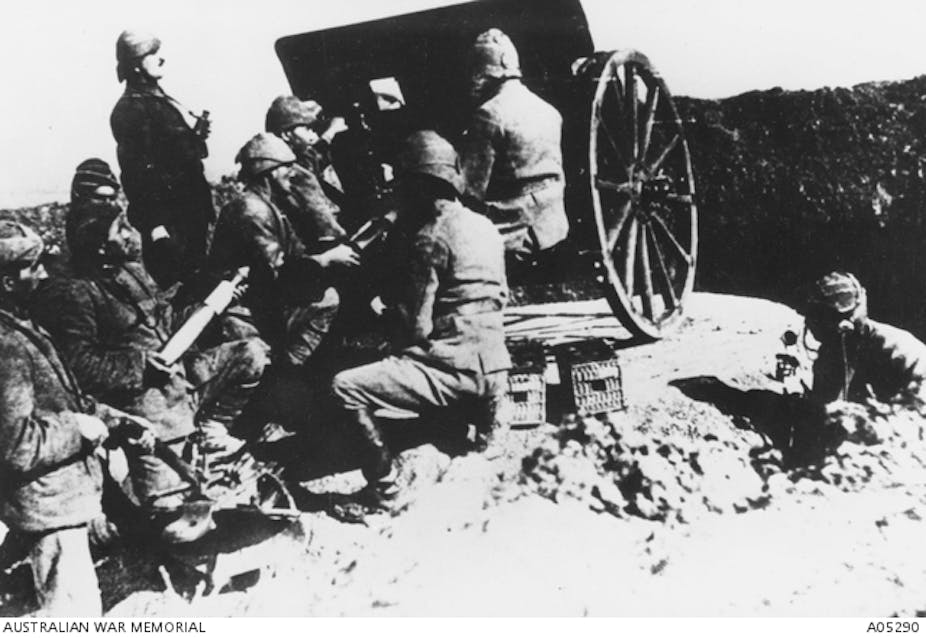There was a moment in Russell Crowe’s latest film, The Water Diviner, that struck a chord with me as a Turkish-Australian. Australian Lieutenant Colonel Cecil Hilton (Jai Courtney) asks Turkish Major Hasan (Yilmaz Erdogan) for help in locating the bodies of the dead Anzacs.
“We lost 10,000 Anzacs here at Gallipoli,” Hilton says. “We still don’t know where half of them are.”
“We lost 70,000 men here at Çanakkale,” replies the Turkish officer. “For me, this place is one big grave.”
This simple conversation between the two characters was one of the stronger points the movie made: the battle resulted in the loss of an entire generation of Turks.
Background to Çanakkale
The Battle of Çanakkale began on November 3, 1914, and lasted until January 9, 1916. For 18 months, Turks were forced to defend their land against invasion. A simple examination of the dates indicates the Anzac battle is but a small part of the larger war.
The first victory came on March 18, 1915. This is a date still celebrated in Turkey as the day of victory in the Battle of Çanakkale.
On that morning, 18 British and French battleships, guarded by other warships, attacked the Dardanelles fort – the narrow strait in northwestern Turkey connecting the Aegean Sea to the Sea of Marmara. The Allied forces were keen to capture the strait. Conquering it would mean direct sea access to Constantinople, now Istanbul, which would subsequently topple the already-shrinking Ottoman Empire.
The British and French would then be linked with the Russians and the stalemate on the Western Front would be brought to an end. It would also be a decisive blow to the Germans, whose side in the war the Ottomans had reluctantly joined.
The sea attack of March 18 was to almost certainly guarantee the passage. As one British officer observed:
No human power could withstand such an array of might and power.
But it wasn’t to be. More than 700 sailors were killed when pre-placed Turkish mines in the Dardanelles sank three battleships. The Brits had suffered a heavy defeat.
They subsequently planned invading the peninsula on foot. British troops would take the tip of the peninsula and the task of cutting through the narrow middle would fall to the Anzacs.
And so, on the morning of April 25, 1915, tens of thousands of young, eager men from Australia and New Zealand arrived at Gallipoli. Their boats mistakenly reached a small cove at Ariburnu, later to be renamed Anzac Cove. What eventuated is a story that has long been told.
Towards a more rounded commemoration
However, what is rare in Australia is an adequate explanation and understanding of the Turkish perspective of the battle.
The rhetoric surrounding Anzac Day is often one of sacrifice. We’ve been told for decades Australian soldiers “sacrificed” their lives for the freedoms we hold today. The question arising from this is a clear one: which part of the freedoms we enjoy today would have not been possible had the British Empire (which we were fighting for) successfully conquered its Ottoman counterpart?
If anything, the notion of “sacrificing for freedoms” is truer for the Turks. Had the hundreds of thousands of young men not joined the army and headed to Gallipoli, had the bravery displayed on the frontlines not happened, it’s without doubt modern Turkey would not have been formed.

By the time the Turkish republic had formed in 1923, the British, French, Italians, Greeks, Australian and New Zealanders had invaded Turkey: all of which had a direct or indirect interest in the acquisition of land for political gain. And with each invasion, the body count in Turkey went up.
It’s the epitome of martyrdom. Without this sacrifice, there would be no freedoms for the Turks to enjoy today.
For the Australians, the battle was one fought for the imperialistic purposes of a self-serving empire, which had control over young Australia’s foreign policy.
For the Turks, it was about defending the nation from enemy invasion.
One of the touching stories of the post-Anzac era is the 1934 address by the mastermind of the Turkish victory and founder of the modern Turkish republic, Mustafa Kemal Ataturk:
Those heroes that shed their blood and lost their lives… You are now lying in the soil of a friendly country. Therefore rest in peace. There is no difference between the Johnnies and the Mehmets to us where they lie side by side now here in this country of ours… You, the mothers who sent their sons from faraway countries, wipe away your tears; your sons are now lying in our bosom and are in peace. After having lost their lives on this land they have become our sons as well.
These words are familiar to Australians, as they’re read at the dawn service in Gallipoli every Anzac Day. They highlight the humility and respect shown by a nation to the fallen – on both sides.
It’s hard to imagine other countries in the modern era doing the same. Vietnam, anyone? Afghanistan? Iraq?
A century on, 10,150 members of the Australian and New Zealand public will gather at Anzac Cove to honour the dead. Many – if not all – will whizz through Gallipoli briefly, visiting the Anzac gravesites. But for the Turks, every inch, every corner, every piece of soil is sacred.
The Water Diviner marks a small yet significant effort in attempting to tell the Turkish side of the battle. One hundred years on from the event, it’s vital we make a collective effort to understand it better.
You can listen to Erdem Koc speak about the Turkish experience of Gallipoli below, in a podcast produced by La Trobe University.

